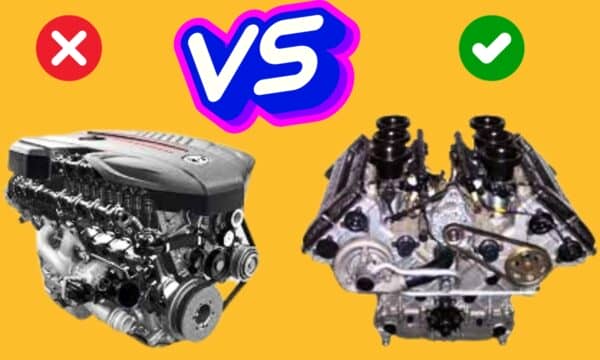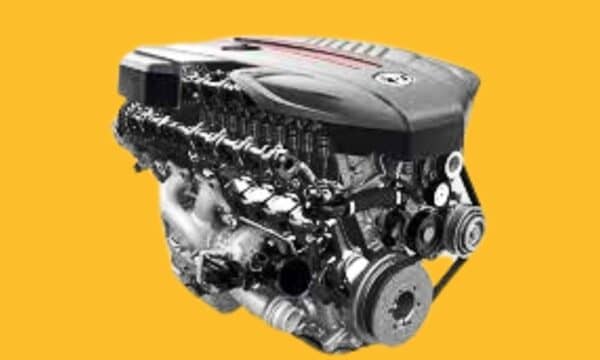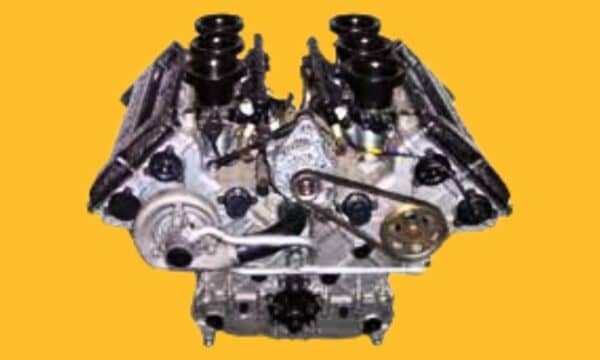Regarding automobile engines, you often hear “6 Cylinder” and “V6”.

Although these terms sound similar and indeed refer to engines with six cylinders, they have different nuances central to understanding engine layouts.
In this article, we will compare a 6 Cylinder versus a V6 engine, exploring their designs, performances, and impacts on your driving experience.
Let’s dive into:
Which is the Best Engine 6 Cylinder or V6?
A 6-cylinder engine, which can be either inline (I6) or V6, typically offers a balance of power, smoothness, and fuel efficiency.
A V6 has its six cylinders arranged in a ‘V’ shape, typically allowing for a more compact design, often leading to a smoother ride.
However, an inline 6-cylinder engine, with all cylinders in a single row, offers greater simplicity and durability, potentially leading to lower maintenance costs.
If you still need clarification on the best one, read this comparison article until the end.
Related: Milwaukee 107 vs 103 Comparision
Comparison 6 Cylinder Vs V6
| Features | 6 Cylinder (General) | V6 Engine |
| Configuration | Inline, Flat | V-Shaped |
| Balance and Smoothness | Varies (I6 is naturally balanced; other configurations might not be) | Generally smooth but can depend on balancing technologies used |
| Size and Compactness | I6 is longer, F6 is wider | More compact than I6; fits well in transverse mounting |
| Common Applications | I6: Luxury/Sports cars, trucksF6: Sports cars | A wide range of vehicles, from luxury and trucks |
| Torque Delivery | Varies (I6 often has smoother torque delivery) | Often has a broad torque band |
| Fuel Efficiency | Depends on the specific configuration and technology used | Generally efficient |
| Performance | Varies with configuration | Solid performance across a wide RPM range |
| Typical Displacement Range | 2.5 to 4.0 Liters | 2.5 to 4.0 Liters |
When comparing a 6-cylinder engine to a V6 engine, it’s important to note that these terms are not mutually exclusive. A V6 is a type of 6-cylinder engine.
The difference lies in the configuration of the cylinders. In a straight or inline 6-cylinder engine, the cylinders are lined up in a row, which can create a longer, narrower engine.
This design can create a smooth and balanced ride. On the other hand, a V6 engine gets its name from the V-shaped configuration of its 6 cylinders.
This arrangement makes the engine more compact, benefiting vehicle design and weight distribution. Still, the ride may need to be smoother due to less engine design balance.
It is up to your specific preferences and needs. Some may prefer the smoothness of a straight 6-cylinder engine, while others may prioritize a more compact design with a V6 engine.
6 Cylinder Engine (Inline)
A 6-cylinder engine is an internal combustion engine that comes with 6 cylinders which are arranged in a straight line (inline). This configuration offers a balance between power, smoothness, and fuel efficiency.
The key features of a 6-cylinder engine include its smooth operation, enhanced power output compared to 4-cylinder engines, and better fuel efficiency than V8 engines.

One major advantage of 6-cylinder engines is their smoothness, as they provide a higher power output, and their configuration leads to an even firing mechanism that reduces vibration.
Moreover, they are more fuel-efficient than larger V8 engines, making them a popular choice for mid-to-large vehicles.
However, there are also some disadvantages associated with 6-cylinder engines. These engines are more expensive than others, and maintenance cost is also higher.
Furthermore, they tend to have lower fuel efficiency than smaller, 4-cylinder engines. Lastly, their larger size might result in a less spacious engine bay, limiting the room for additional enhancements or repairs.
Despite these drawbacks, 6-cylinder engines remain popular among car enthusiasts for their smooth operation and balanced power output.
They are commonly used in sports cars, luxury sedans, and SUVs, making them versatile for various vehicle types.
What Problems Could You Face With 6 Cylinder Inline Engine?
There are some common problems that many users experience with their vehicle inline 6 Cylinder engines.
Overheating
Most users experience overheating issues on long routes, but several factors produce excessive heat. If the radiator, water pump, or thermostat is malfunctioning, it could lead to overheating.
You should regularly check these components for signs of any damage or fault. Because if these parts are faulty, they may lead to overheating, which could further damage the other engine parts.
Suppose any component, like a radiator, water pump, or thermostat, is faulty. In that case, you should immediately repair or replace them to fix the overheating issues.
Oil Leaks
Oil leaks can result from a damaged gasket or seal. Which also produces several potential impacts on the engine performance.
You should regularly check the maintenance to avoid leaks early. Use high-quality seals during replacements to ensure longevity.
Power Loss
Sometimes, the engine may lose power due to old spark plugs, a clogged air filter, or a compromised fuel system.
Regular servicing, changing the spark plugs, and cleaning or replacing the air filter can help address this issue.
Rough Idling
Another common problem with 6-cylinder inline engines is rough idling. This can be due to various factors, such as dirty fuel injectors, a faulty ignition coil, or a malfunctioning EGR valve.
Regularly cleaning and maintaining these components can help prevent rough idling.
V6 Engine
The V6 engine, named for its V-shaped configuration with three cylinders on each side, is one of the most popular and versatile engine types. Its compact size and balance make it a favourite for many sports cars and family SUVs.
Featuring a more compact design than straight engines, the V6 fits neatly into modern cars with smaller engine bays while delivering significant power.

V6 engines are also known for their smooth operation, translating into a comfortable ride. However, there are some drawbacks associated with V6 engines.
These complex engines may be more costly to maintain and repair than their four-cylinder counterparts.
They also tend to consume more fuel, which can be a significant consideration for budget-conscious drivers.
Still, the balance of power, smoothness, and size make the V6 engine a popular choice for many drivers.
In terms of power, the V6 engine delivers more horsepower and torque than a four-cylinder engine, making it an excellent choice for vehicles requiring extra power, such as towing or hauling.
One of the primary factors contributing to the popularity of V6 engines is their balance. The V6 engine’s layout allows for reduced vibrations and smoother operation, resulting in a more comfortable driving experience.
The compact design also makes it possible to include this engine type in smaller cars without sacrificing performance or space.
What Problems Could You Face with the V6 Engine?
Several common issues may arise with a v6 engine.
Overheating
One of the most common problems is overheating, caused by a faulty radiator, water pump, or thermostat.
To fix this, first identify the exact problem, replace the necessary parts, and ensure the coolant is topped up and flowing smoothly.
Oil Leakage
Another prevalent issue is oil leaks, typically resulting from worn-out gaskets or seals. Fixing an oil leak might require replacing these gaskets or seals and should ideally be done by a trained mechanic.
Misfiring
A misfiring engine is also a common problem with v6 engines; worn-out spark plugs, fuel injectors, or ignition coils can cause it. The solution to this issue involves replacing the faulty parts.
Timing Belt Failure
Lastly, timing belt failure is a serious issue that can cause significant engine damage in v6 engines. It would help to replace the timing belt according to the manufacturer’s recommendation.
Always consult a professional mechanic when dealing with these issues to ensure they are properly addressed.
FAQs
Is a V6 better than a 6-cylinder?
Yes, the V6 engine is better than general 6-cylinder engines due to its V-arrangement, which provides more torque at higher speeds, reduced friction, and more efficient performance.
Are V6 and 6 cylinder the same?
A V6 engine is a 6-cylinder engine different from the simple straight-forward inline engine.
In general 6, 6-cylinder engine cylinders are arranged in a line where these cylinders are arranged in V-Shap in the case of a V6 engine.
Does V6 consume more fuel?
V6 engines consume more fuel than the I6 or 4-cylinder engines.
Conclusion
V6 engine is the modern shape of 6 6-cylinder engine, and there is a clear difference between the design of both engines.
Cylinders are arranged in a line for the I6 engine, configured in a V shape in the case of the V6 engine.
V6 engines consume more fuel than normal 6-cylinder engines and produce more torque at higher speeds.

Ahtsham Younas is a passionate blogger and content writer. He loves to ride motorcycles and learn the mechanical process behind the motorcycles.
He has been writing articles in the motorcycle industry since 2019 and has learned many things about motorbike niches.


